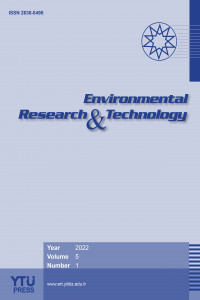Conference Paper
Year 2022,
Volume: 5 Issue: 1, 1 - 10, 31.03.2022
Abstract
References
- [1]. F. G. Bell, “Lime stabilization of clay minerals and soils,” Engineering Geology, vol. 42, no. 4, pp. 223-237, 1996.
- [2]. S. K. Dash and M. Hussain, “Lime stabilization of soils: reappraisal,” Journal of Materials in Civil Engineering, vol. 24, no. 6, pp. 707-714, 2012.
- [3]. M. R. Abdi and S. Wild, “Sulphate expansion of lime-stabilized kaolinite: Physical characteristics,” Clay Minerology, vo. 28, no. 4, pp. 555-567, 1993.
- [4]. C. M. Geiman, “Stabilization of soft clay subgrades in Virginia; Phase I laboratory study,” M.S. Thesis, Virginia Polytechnic Institute and State University, Blacksburg, VA, USA, 2005.
- [5]. J. E. Barker, C. D. F. Rogers, and D. I. Boardman, “Physiochemical changes in clay caused by ion migration from lime piles,” Journal of Materials in Civil Engineering, vol. 18, no. 2, pp. 182-189, 2006.
- [6]. ASTM 2435, “Standard test method for one-dimensional consolidation properties of soils,” ASTM International, West Conshohocken, PA, USA, 2003.
Year 2022,
Volume: 5 Issue: 1, 1 - 10, 31.03.2022
Abstract
Lime soil treatment is a chemical process in which lime (quicklime, hydrated lime or lime slurry) is mixed with the in place subgrade soil and a chemical reaction takes place. The lime reacts with the clay particles in the soil to create a cementitious matrix. The design of landfill base liners including a clay layer as a fluid barrier (i.e. water-resistant impervious layer) requires a neat engineering approach considering, in particular, consolidation behavior as well as hydraulic properties of the clay contained. For sake of safe and stable design of such baseliners under the landfills, the reduction of consolidation settlement in clay when subjected to the accumulated waste load (i.e. superposed action) during operation as well as the accomplishment for ensuring the waterproof of those composite base liners (comprised of multiple different layers) not to allow the penetration of the contaminated water - produced as a result of exothermic reactions occurring in the waste body in landfills – by enabling enhanced isolation from the natural ground is of importance. In light of this, in order to address those two most important design concerns (i.e. Consolidation and Hydraulic Properties of Clay) as well as to in an at- tempt to develop an enhanced clay layer system for landfill baseliners that has a greater bearing capacity (i.e. load resistance), and hence, more robust against settlements, and additionally, possessing improved hydraulic properties by being relatively more water-resistant and greatly impermeable, a series of consolidation tests were performed in the laboratory at different lime contents (lime/lime-clay mixture proportions by weight: 0%, 10%, and 20%) on clay specimens to investigate the stabilization and improvement of clayey landfill baseliners. Lime treatment on clay specimens has shown as a result of the experimental program that the strength of clay against loading improves, and further, exhibits less vertical deformation (settlement) under the load owing to an increase in lime content. Moreover, the clay becomes highly impermeable and displays substantially larger water-resistant properties because of increased lime mass proportion in clayey soil. The findings of the experimental program demonstrate that lime stabilization of the clayey soils in landfill baseliners will benefit the bearing capacity and the imperviousness (water tightness) engineering design properties as compared to standard composite multi-layered landfill baseliner systems.
Keywords
Clayey Soils Consolidation behavior Hydrolic properties Landfill base liners Lime stabilization
References
- [1]. F. G. Bell, “Lime stabilization of clay minerals and soils,” Engineering Geology, vol. 42, no. 4, pp. 223-237, 1996.
- [2]. S. K. Dash and M. Hussain, “Lime stabilization of soils: reappraisal,” Journal of Materials in Civil Engineering, vol. 24, no. 6, pp. 707-714, 2012.
- [3]. M. R. Abdi and S. Wild, “Sulphate expansion of lime-stabilized kaolinite: Physical characteristics,” Clay Minerology, vo. 28, no. 4, pp. 555-567, 1993.
- [4]. C. M. Geiman, “Stabilization of soft clay subgrades in Virginia; Phase I laboratory study,” M.S. Thesis, Virginia Polytechnic Institute and State University, Blacksburg, VA, USA, 2005.
- [5]. J. E. Barker, C. D. F. Rogers, and D. I. Boardman, “Physiochemical changes in clay caused by ion migration from lime piles,” Journal of Materials in Civil Engineering, vol. 18, no. 2, pp. 182-189, 2006.
- [6]. ASTM 2435, “Standard test method for one-dimensional consolidation properties of soils,” ASTM International, West Conshohocken, PA, USA, 2003.
There are 6 citations in total.
Details
| Primary Language | English |
|---|---|
| Subjects | Environmental Engineering |
| Journal Section | Conference Paper |
| Authors | |
| Publication Date | March 31, 2022 |
| Submission Date | January 13, 2021 |
| Acceptance Date | January 4, 2022 |
| Published in Issue | Year 2022 Volume: 5 Issue: 1 |


